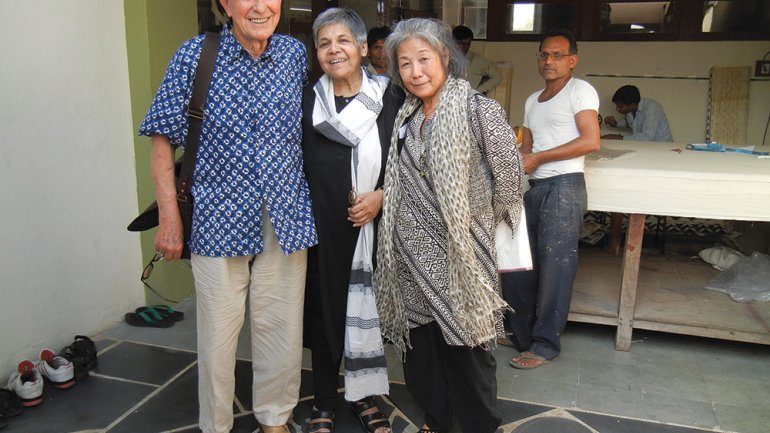Globe-Trotter
Globe-Trotter
For decades, the name Jack Lenor Larsen has been tantamount to innovation in textile design. Beginning with the incorporation of his namesake firm in 1953, the inspirational designer, an ACC Gold Medalist, has produced thousands of chic fabrics. He’s also the founder of LongHouse Reserve, a public garden and art collection in East Hampton, New York, and an avid global traveler. In the course of his varied career, Larsen says, it has been his privilege to work in dozens of countries. For our travel and museums issue, we asked him to share his insights on the world at large.
You recently returned from a long trip. Where did you go? What were you doing?
In October, I attended a textile design conference in Istanbul at a leading textile college right on the Golden Horn. It made sense to me; Turkey has become the largest textile producer in Europe. From there, on to Jerusalem to see the Israel Museum that James Carpenter designed so well, combining the Shrine of the Book and the Noguchi sculpture garden with the original museum into one magnificent campus.
Then on to Doha, capital of Qatar and home to one of I.M. Pei’s most recent buildings, the Museum of Islamic Art – the most spectacular place I have ever seen. On its own island within the man-made harbor, its composition looks like 100 abstract paintings with some reference to Near Eastern history. The examples inside – vessels, mosaics, calligraphy – are all treated as the superb art they are, with glorious backgrounds and unparalleled lighting.
In India, I joined a LongHouse tour, crossing over from Agra to Ahmedabad and then to Kutch. Although I’ve known India for 50 years and worked there often, seeing Kutch was like the subcontinent ages ago – with people still in traditional dress, and rural villages.
You’ve described LongHouse as “an outgrowth of [your] feeling that we learn best in three dimensions.” Does that extend to travel? Especially considering that today so much of the world can be experienced through media?
The most meaningful way to experience art, architecture, and landscape is to be there in the flesh – to be in the right scale, light, and ambiance. It’s real and often indelible.
In terms of experiencing travel without going, I think this has been done best when the subject is small and intimate. The Victoria and Albert recently did a mammoth design show on modernism. They had virtual tours of Corbusier’s great Villa Savoye and Mies van der Rohe’s Barcelona Pavilion. These were wonderfully done, with the camera focusing on just exactly what one should see – and probably more knowingly than one would have seen walking through the space. Superb and rare.
What has travel meant to you?
I’m not an artist, but a craftmaker and a weaver, very individual. I feel our greatest responsibility is to become ourselves – not the sheep that industry and government would like us to be, but true individuals. For this, travel has probably helped as much as anything else, because one sees people in very different modes and mores, bringing into question whether the American norm is the only or best norm. Not even that their ways are better than ours, but that ours are not necessarily better. Question them!
What are some of your favorite places to visit? Favorite museum textile collections?
Japan is still a favorite country, as it was when I was a student at the University of Washington. This autumn our LongHouse tour to Japan will be my 40th visit. If I used to go for “old Japan,” I now enjoy Tokyo as the world’s most modern city.
If most every city has textile museums, the Abegg Foundation’s museum near Bern, Switzerland, has the most remarkable collections, with only the best of the best. To see 2,000-year-old Paracas costumes in Lima, Peru, on mannequins is also still exciting. And the recent shows at our Textile Museum in Washington, DC, have been spectacular.
Speaking of textile collections, my best experience was working with the great Alfred Bühler at the ethnographic museum in Basel. He was, beyond all else, the pope of resists, having read the rules and the books and set the records.
Can you tell us what you’re currently working on? What’s next for you?
Our current project here is upholstery fabrics for the new Shakespeare theater near the Brooklyn Academy of Music. They’re happy, as am I, that we are weaving the fabric at a small mill in Brooklyn. I design less now in terms of textiles, but am very involved with the landscaping and sculpture exhibitions at LongHouse, where I’ve become almost a full-time curator.
It took me a long time to really grow up. I was productive and successful as a young person and worked on that pretty much full time. I enjoy being an adult – even a senior – enormously. I have the freedom now to say what’s on my mind.
I’m also privileged to have an extraordinary memory for what is important to me – and it’s not my phone number. I recall Eleanor Roosevelt’s words: Today is a gift!
Jessica Shaykett is the American Craft Council librarian.

